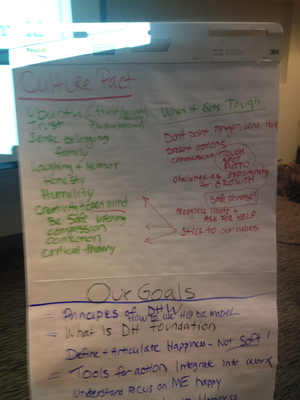There has been no shortage of web ink dedicated lately to the topic of teams having their work from home agreements limited or terminated, Yahoo! being most notable among these. But what if geographical distribution of your team is necessary for effective functioning of your business?
At 360, we have had a distributed team since day one but now with operations in four U.S. states, Port-Au-Prince Haiti, our head office just outside Toronto and our newly opened office in London, UK, ensuring that the company culture flows freely through the entire organization has become a bit of an ongoing but fun challenge.
 When an organization faces a big challenge, it's great to have resources to draw from that are equal to the task. Thursday afternoon, I was extremely fortunate to have time to sit down and have a chat with Jenn Lim, co-founder and Chief Happiness Officer of Delivering Happiness.
When an organization faces a big challenge, it's great to have resources to draw from that are equal to the task. Thursday afternoon, I was extremely fortunate to have time to sit down and have a chat with Jenn Lim, co-founder and Chief Happiness Officer of Delivering Happiness.
I had originally set out to ask Jenn if she believes it possible to effectively keep a distributed team in alignment with a company's values and culture. During my time with her amazing team over an energizing few days however, I have come to learn that the Delivering Happiness (DH) team works out of San Francisco, Sydney, Atlanta, Barcelona and Geneva to name a few. So the question became a slightly more tactical one: how to make it work?
Here are Jen's tips for engaging with your team in a meaningful, sustainable way when geography gets in the way:
Leverage Technology
"Technology is our main tool," says Lim. "We use it for only what benefits us as people: interactions, communication and connectedness. With people working out of Sydney, Atlanta, Geneva, San Francisco, the challenge is how to build connectedness that is sustainable and meaningful."
To address this, DH has implemented an every week mandatory all hands call, using a tool called Fuzebox. This enables the team to "meet" in real time to talk about business and work stuff to keep everyone aligned, but it is also just as much about connection. "Each week one person will present on what inspires them the most, what they're into outside of work, says Lim." "By combining those two things, we can keep the meaningful connections alive, even though we're not in the same location."
Lim says that in organizations where the bulk of the team might work in a centralized location such as a head office, it is critically important to have remote people present to the group regularly via online meeting and companies must make the extra effort to pull the remote workers into the huddle.
Additionally, the DH team holds a physical all-hands meeting every quarter somewhere in the world. Lim calls this meeting a "workcation" and notes "it's time off, but time together." The key to making these events productive and worthwhile is the person who spearheads the gatherings. "That person should have a strong gravitational pull on the group," says Lim.
The Culture Is Still The Thing
There should already be a cultural fit and that is the real DNA of what makes it work, but Lim says "every person has this sort of light switch, where when you talk about a certain something with them and it's like 'BOOM' something big comes out of it and we all have a responsibility to bring that out in each other."
To create an environment where people are connecting at that "boom" level that Jenn refers to, workgroups must have the discipline to take the time to establish shared values that will guide the working dynamic. This will be the cornerstone of the group's culture upon which the rest will be built.
 Having worked closely with the DH team for three days earlier this week, I would add that it is worth noting that the team takes the time to establish a micro-culture among a working group getting together for the first time in order to build comfort and trust among the collaborators and help ensure the most productive discourse.
Having worked closely with the DH team for three days earlier this week, I would add that it is worth noting that the team takes the time to establish a micro-culture among a working group getting together for the first time in order to build comfort and trust among the collaborators and help ensure the most productive discourse.
I asked Jenn if she thought there were any typical pitfalls that a distributed team might take note of to avoid and her answer was reflective of how important the DH team holds their shared values: "you don't have to worry too much if you've hired the right people."
Measurement + Action
Finally, Lim checks the pulse of her team quarterly with the Happiness At Work survey, developed with TED alumnus Nic Marks. This simple online tool lets her know if everyone is still feeling connected to the group in a meaningful way and gives actionable input as to how the company could work better from the team's perspective. Here is where it is critically important to take action.
The DH team works with companies around the world helping them describe their values, then crafting and implementing company cultures and here is where it can all go wrong. Lim's one word instruction once you have all the inputs, especially what you could do better in the eyes of your team?
"Do."
This post originally appeared on the 360incentives blog.

